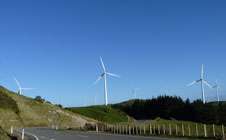Interconnecting distant NZ windfarms could be boon for grid

Variable winds—even in New Zealand's most blustery locations—make it difficult for windfarms to contribute more fully to the national grid, but now University of Otago research points the way to achieving a highly reliable supply of wind power.
A new study by the Department of Geography's Dr Nicolas Cullen and his former Master's student Peter Gibson indicates that interlinking windfarms across different regions of the country could boost generation reliability from New Zealand windfarms.
The pair made the discovery after carefully analysing New Zealand's wind circulation patterns alongside five years of synthesised wind speed data from 15 existing or proposed wind farm sites.
Dr Cullen says they calculated that even just a two-region network linking windfarms in far northern and southern regions of the country could substantially reduce zero-generation hours.
"We essentially found that if the weather is poor for generating power in the Far North, there is a good chance conditions will be favourable for generation in Otago and Southland, and vice versa," Dr Cullen says.
This phenomenon and similar, though less pronounced, variations between other regions mean that interconnecting wind farms through high-voltage direct current (HVDC) technology would largely solve supply reliability issues, he says.
Mr Gibson says that their research found that weather patterns influence New Zealand windfarms in different ways due to a range of climatological and geographical factors.
"Traditional methods for wind farm site selection do not take this into account, so our findings have implications for the future planning and site selection of windfarm projects in New Zealand," he says.
Dr Cullen says that interconnecting distant windfarms could help meet Government targets of moving from 73 percent of electricity generation from renewable sources to 90 percent by 2025.
"Our wind resources are some of the best in the world, but currently this renewable provides only 5 percent of New Zealand's total generation. There is a lot of scope to grow its contribution and greatly reduce, or ideally eliminate, generation from fossil fuels," he says.
The study appears in the May issue of the US Journal of Applied Meteorology and Climatology.
Provided by University of Otago




















